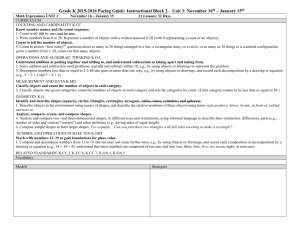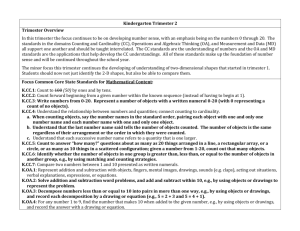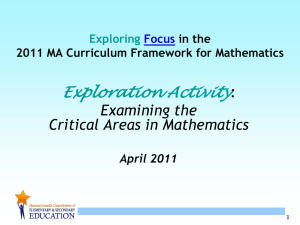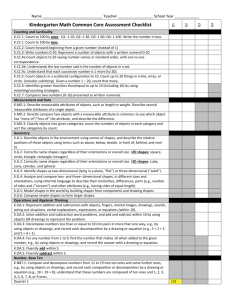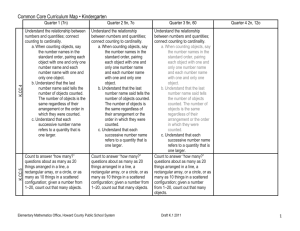Focus Standards for Mathematical Practice Module 1
advertisement
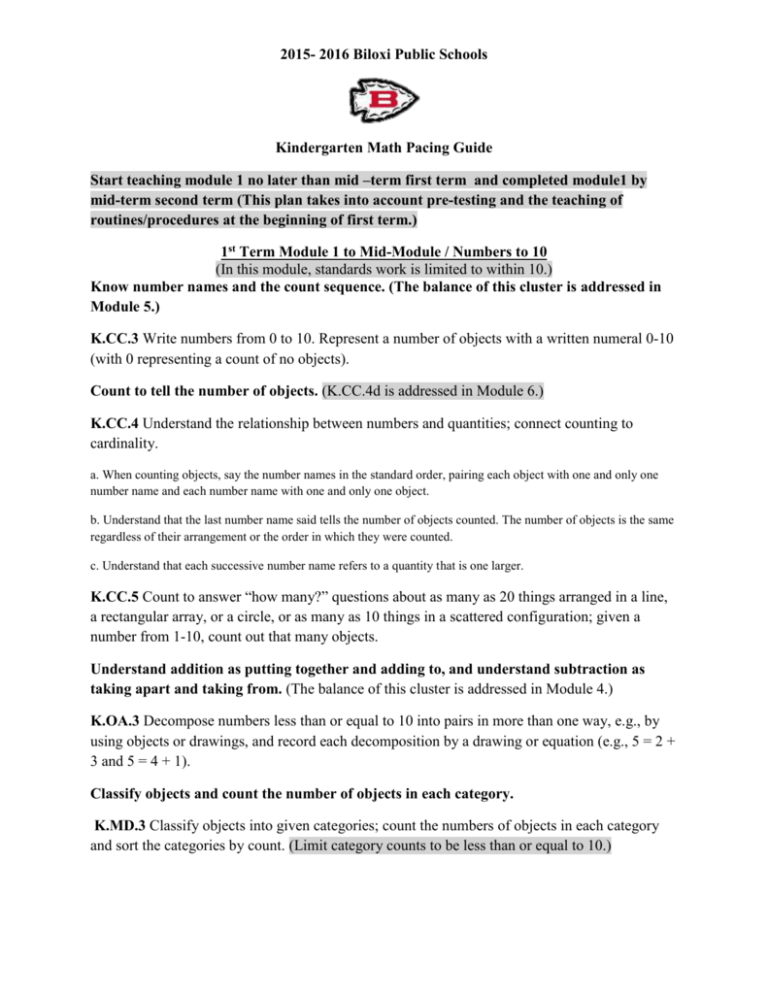
2015- 2016 Biloxi Public Schools Kindergarten Math Pacing Guide Start teaching module 1 no later than mid –term first term and completed module1 by mid-term second term (This plan takes into account pre-testing and the teaching of routines/procedures at the beginning of first term.) 1st Term Module 1 to Mid-Module / Numbers to 10 (In this module, standards work is limited to within 10.) Know number names and the count sequence. (The balance of this cluster is addressed in Module 5.) K.CC.3 Write numbers from 0 to 10. Represent a number of objects with a written numeral 0-10 (with 0 representing a count of no objects). Count to tell the number of objects. (K.CC.4d is addressed in Module 6.) K.CC.4 Understand the relationship between numbers and quantities; connect counting to cardinality. a. When counting objects, say the number names in the standard order, pairing each object with one and only one number name and each number name with one and only one object. b. Understand that the last number name said tells the number of objects counted. The number of objects is the same regardless of their arrangement or the order in which they were counted. c. Understand that each successive number name refers to a quantity that is one larger. K.CC.5 Count to answer “how many?” questions about as many as 20 things arranged in a line, a rectangular array, or a circle, or as many as 10 things in a scattered configuration; given a number from 1-10, count out that many objects. Understand addition as putting together and adding to, and understand subtraction as taking apart and taking from. (The balance of this cluster is addressed in Module 4.) K.OA.3 Decompose numbers less than or equal to 10 into pairs in more than one way, e.g., by using objects or drawings, and record each decomposition by a drawing or equation (e.g., 5 = 2 + 3 and 5 = 4 + 1). Classify objects and count the number of objects in each category. K.MD.3 Classify objects into given categories; count the numbers of objects in each category and sort the categories by count. (Limit category counts to be less than or equal to 10.) 2015- 2016 Biloxi Public Schools Kindergarten Math Pacing Guide 2nd Term Complete Module 1 before Mid- Term & Start Module 2 by Mid-Term Second Term and Complete by the End of Second Term 2nd Term Module 2 to End of -Module Classify objects and count the number of objects in each category. K.MD.3 Classify objects into given categories; count the numbers of objects in each category and sort the categories by count. (Limit category counts to be less than or equal to 10.) Identify and describe shapes (squares, circles, triangles, rectangles, hexagons, cubes, cones, cylinders, and spheres). K.G.1 Describe objects in the environment using names of shapes, and describe the relative positions of these objects using terms such as above, below, beside, in front of, behind, and next to. K.G.2 Correctly name shapes regardless of their orientations or overall size. K.G.3 Identify shapes as two-dimensional (lying in a plane, “flat”) or three-dimensional (“solid”). Analyze, compare, create, and compose shapes. (The balance of this cluster is addressed in Module 6.) K.G.4 Analyze and compare two- and three-dimensional shapes, in different sizes and orientations, using informal language to describe their similarities, differences, parts (e.g., number of sides and vertices/”corners”) and other attributes (e.g., having sides of equal length). 2015- 2016 Biloxi Public Schools Kindergarten Math Pacing Guide Module 3 (Start and Complete Third Term) Compare numbers. K.CC.6 Identify whether the number of objects in one group is greater than, less than, or equal to the number of objects in another group, e.g., by using matching and counting strategies. (Include groups with up to 10 objects.) K.CC.7 Compare two numbers between 1 and 10 presented as written numerals. Describe and compare measurable attributes. K.MD.1 Describe measurable attributes of objects, such as length or weight. Describe several measurable attributes of a single object. K.MD.2 Directly compare two objects with a measurable attribute in common, to see which object has “more of”/”less of” the attribute, and describe the difference. For example, directly compare the heights of two children and describe one child as taller/short Module 4 (Start Module 4 Third Term and Complete Module4 Fourth Term) Mid-Module Understand addition as putting together and adding to, and understand subtraction as taking apart and taking from. K.OA.1 Represent addition and subtraction with objects, fingers, mental images, drawings, sounds (e.g., claps), acting out situations, verbal explanations, expressions, or equations. (Drawings need not show details, but should show the mathematics in the problem. This applies wherever drawings are mentioned in the Standards.) K.OA.2 Solve addition and subtraction word problems, and add and subtract within 10, e.g., by using objects or drawings to represent the problem. K.OA.3 Decompose numbers less than or equal to 10 into pairs in more than one way, e.g., by using objects or drawings, and record each decomposition by a drawing or equation (e.g., 5 = 2 + 3 and 5 = 4 + 1). K.OA.4 For any number from 1 to 9, find the number that makes 10 when added to the given number, e.g., by using objects or drawings, and record the answer with a drawing or equation. K.OA.5 Fluently add and subtract within 5. 2015- 2016 Biloxi Public Schools Kindergarten Math Pacing Guide 4th Term Module 4 (Complete Module 4 Fourth Term) End of Module Understand addition as putting together and adding to, and understand subtraction as taking apart and taking from. K.OA.1 Represent addition and subtraction with objects, fingers, mental images, drawings, sounds (e.g., claps), acting out situations, verbal explanations, expressions, or equations. (Drawings need not show details, but should show the mathematics in the problem. This applies wherever drawings are mentioned in the Standards.) K.OA.2 Solve addition and subtraction word problems, and add and subtract within 10, e.g., by using objects or drawings to represent the problem. K.OA.3 Decompose numbers less than or equal to 10 into pairs in more than one way, e.g., by using objects or drawings, and record each decomposition by a drawing or equation (e.g., 5 = 2 + 3 and 5 = 4 + 1). K.OA.4 For any number from 1 to 9, find the number that makes 10 when added to the given number, e.g., by using objects or drawings, and record the answer with a drawing or equation. K.OA.5 Fluently add and subtract within 5. Module 5 Know number names and the count sequence. K.CC.1 Count to 100 by ones and by tens. K.CC.2 Count forward beginning from a given number within the known sequence (instead of having to begin at 1). K.CC.3 Write numbers from 0 to 20. Represent a number of objects with a written numeral 0–20 (with 0 representing a count of no objects). 2015- 2016 Biloxi Public Schools Kindergarten Math Pacing Guide Count to tell the number of objects. (K.CC.4a is addressed in Module 1; K.CC.4d is addressed in Module 6.) K.CC.4 Understand the relationship between numbers and quantities; connect counting to cardinality. b. Understand that the last number name said tells the number of objects counted. The number of objects is the same regardless of their arrangement or the order in which they were counted. c. Understand that each successive number name refers to a quantity that is one larger. K.CC.5 Count to answer “how many?” questions about as many as 20 things arranged in a line, a rectangular array, or a circle, or as many as 10 things in a scattered configuration; given a number from 1–20, count out that many objects. Work with numbers 11–19 to gain foundations for place value. K.NBT.1 Compose and decompose numbers from 11 to 19 into ten ones and some further ones, e.g., by using objects or drawings, and record each composition or decomposition by a drawing or equation (e.g., 18 = 10 + 8); understand that these numbers are composed of ten ones and one, two, three, four, five, six, seven, eight, or nine ones. Module 6 Count to tell the number of objects. (Ordinality is introduced in the context of constructing and manipulating shapes. The balance of this cluster is addressed in Modules 1 and 5.) Analyze, compare, create, and compose shapes. (K.G.4 is addressed in Module 2.) K.G.5 Model shapes in the world by building shapes from components (e.g., sticks and clay balls) and drawing shapes. K.G.6 Compose simple shapes to form larger shapes. For example, “Can you join these two triangles with full sides touching to make a rectangle?” 2015- 2016 Biloxi Public Schools Kindergarten Math Pacing Guide Focus Standards for Mathematical Practice Module 1 MP.2 Reason abstractly and quantitatively. Students represent quantities with numerals. MP.3 Construct viable arguments and critique the reasoning of others. Students reason about each other’s ways of counting fingers or a scattered set of objects. They reason about counting fingers by comparing the fingers counted and about scattered objects by comparing counting paths through a set of up to 10 scattered objects. MP.4 Model with mathematics. Students model decompositions of three objects as math drawings and addition equations. MP.7 Look for and make use of structure. Students use the 5-group to reason about numbers within 10. MP.8 Look for and express regularity in repeated reasoning. Students build a number stair to reason about 1 more and 1 less than each number within 10. Focus Standards for Mathematical Practice Module 2 MP.1 Make sense of problems and persevere in solving them. Students distinguish shapes from among variants, palpable distractors, and difficult distractors.2 (See examples to the right). MP.3 Construct viable arguments and critique the reasoning of others. Students are increasingly able to use shape attributes to defend identification of a plane or solid shape. MP.6 Attend to precision. Students use position words to clearly indicate the location of shapes. Also, when kindergarten students are analyzing and defining attributes such as “3 straight sides” they are attending to precision. MP.7 Look for and make use of structure. Students use examples, non-examples, and shared attributes of geometric figures in order to develop a richer concept image (Geometry Progressions, p. 6) of each geometric shape. This concept image allows for more acute discernment of the shape within the environment. 2015- 2016 Biloxi Public Schools Kindergarten Math Pacing Guide Focus Standards for Mathematical Practice Module 3 MP.2 Reason quantitatively and abstractly. Students compare quantities by drawing objects in columns and matching the objects one to one to see that one column has more than another and draw the conclusion that 6 is more than 4 because 2 objects do not have a match. MP.3 Construct viable arguments and critique the reasoning of others. Students describe measurable attributes of a single object and reason about how to compare its length, weight, and volume to that of another object. MP.5 Use appropriate tools strategically. During the culminating task and End-of-Module Assessment, students might choose to use a scale to compare weight, linking cube sticks to compare length and rice and cups to compare volume. Focus Standards for Mathematical Practice Module 4 MP.1 Make sense of problems and persevere in solving them. Students identify story problems as addition or subtraction situations and find the unknown. Students demonstrate with drawings and verbal explanations the referent of each number in a given problem type. MP.2 Reason abstractly and quantitatively. Students reason about the relationships between numbers in composition and decomposition situations. For example, they can use the number bond mat to show and explain that 6 and 4 make 10, and that 10 can be broken into 6 and 4. MP.4 Model with mathematics. Students use number bonds and addition and subtraction equations to model composition and decomposition. Students tell story problems using drawings, numbers, and symbols. MP.5 Use appropriate tools strategically. Students select and use tools such as drawings, number bonds, and the number path to solve problems. MP.7 Look for and make use of structure. Students draw the 5 + n pattern to reason about numbers within 10. MP.8 Look for and express regularity in repeated reasoning. Students add and subtract 0 to get the same number. They also use linking cubes to add and subtract 1 to reason about 1 more and 1 less than with numbers to 10. 2015- 2016 Biloxi Public Schools Kindergarten Math Pacing Guide Focus Standards for Mathematical Practice Module 5 MP.2 Reason abstractly and quantitatively. Students represent teen numerals with concrete objects separated as 10 ones and some ones. MP.3 Construct viable arguments and critique the reasoning of others. Students explain their thinking about teen numbers as 10 ones and some ones and how to represent those numbers as addition sentences. MP.4 Model with mathematics. Students model teen quantities with number bonds, place value cards, and teen numbers. MP.7 Look for and make use of structure. Students use the structure of 10 ones to reason about teen numbers. They compare teen numbers using the structure of the 10 ones to compare the some ones. Focus Standards for Mathematical Practice Module 6 MP.1 Make sense of problems and persevere in solving them. Students persist in their use of trial and error until they begin to use the attributes of a puzzle to determine which shape fits into an open space. “The empty space has a long side like my triangle. Let’s see if my triangle fits.” MP.4 Model with mathematics. Students use shapes to create pictures of common objects and use straws and clay to create models of two- and three-dimensional objects in their environment. MP.6 Attend to precision. Ordinal numbers provide students with vocabulary to precisely describe the spatial organization of ten shapes in a straight line. MP.7 Look for and make use of structure. Students make use of their understanding of a shape’s attributes to build three-dimensional shapes from two-dimensional shapes.
